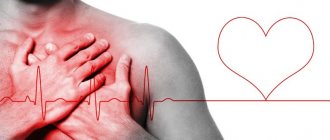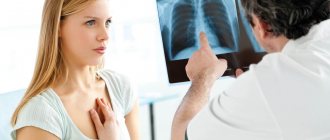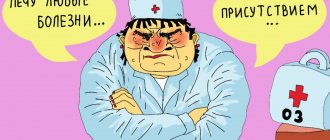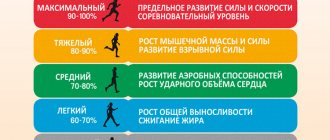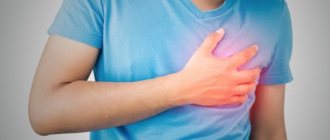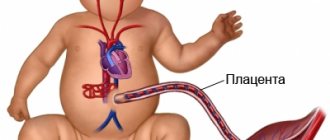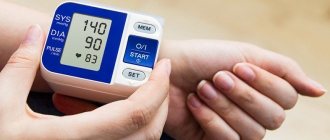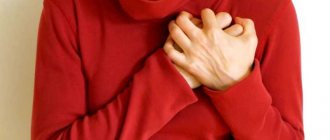From the article you will learn about the causes of sudden lack of air, why it compresses the chest and it becomes difficult to breathe, what to do and how to stop the attack.
When a person has difficulty breathing, a feeling of suffocation occurs - this indicates a lack of normal oxygen supply to the human body.
This condition is regarded as a marker of serious diseases of the cardiovascular, central nervous and autonomic systems, pathologies of the lungs, blood and some other conditions (pregnancy, hormonal imbalance, physical activity, and so on).
Types of shortness of breath
Depending on the respiratory rate, shortness of breath is diagnosed as tachypnea - more than 20 breaths/minute or bradypnea - less than 12 breaths/minute. In addition, there is a distinction between shortness of breath on inspiration - inspiratory and on exhalation - expiratory. There may be a mixed version of dyspnea. There are other characteristics of difficulty breathing that correlate with the causes of the pathological condition:
- with mechanical obstruction of the respiratory tract, shortness of breath of a mixed type occurs, the age is often childhood, there is no sputum, the presence of a foreign body causes inflammation;
- with anemia, the type of shortness of breath is also mixed, there is no sputum, but the symptoms develop gradually, the peculiarity is pale skin, diagnosis of the trigger of the pathology is needed;
- with ischemic heart disease , breathing is heavy when inhaling with bubbling wheezing, often dyspnea at night, attacks, while acrocyanosis is obvious, cold extremities, swollen neck veins, a lot of sputum, age – elderly;
- traumatic brain injury causes arrhythmic shortness of breath of a mixed type, there is no sputum, convulsions, paralysis, loss of consciousness are possible, coughing and severe wheezing are sometimes heard, there are no age or gender differences;
- narrowing of the bronchi, loss of elasticity of the lungs causes difficulty or rapid breathing;
- cerebral dyspnea appears due to pathological irritation of the respiratory center (tumor, hemorrhage), a lump in the throat, difficulty breathing and cough are possible.
Why are the symptoms dangerous?
If there is not enough air, that is, it becomes difficult to breathe, and a rapid heartbeat appears, then we can talk about the development of a dangerous pathological process. The problem is most often associated with heart failure and coronary artery disease. In the first case, a person experiences shortness of breath (dyspnea), which intensifies with physical activity, and the pulse quickens due to the inability of the heart to provide adequate blood supply to the body. With ischemia, tachycardia develops due to impaired patency of the coronary vessels due to the development of atherosclerosis.
There are other causes for shortness of breath and rapid heartbeat:
- vegetative-vascular dystonia (VSD);
- myocardial infarction;
- panic attack;
- stroke.
Pathological causes are dangerous due to their complications. Constant hemodynamic disruptions lead to the formation of blood clots and dysfunction of internal organs.
If your heart beats strongly and it’s hard to breathe after stress, taking medications and physical overload, then the problem lies in the influence of physiological factors. This reaction often occurs in older people. The symptoms that arise can be eliminated by changing your lifestyle.
Main causes of breathing problems
When it is difficult to breathe and there is not enough air, the cause may be various physiological processes, which are controlled by a special substance - surfactant, lining the inner surface of the lungs. The essence of its action is the unhindered penetration of oxygen into the bronchopulmonary tree, preventing the collapse of the walls of the alveoli during breathing, improving local immunity, protecting the bronchial epithelium, and preventing hypoxia. The less surfactant, the more difficult it is for a person to breathe.
The causes of difficulty breathing can also be pathological conditions: stress, allergies, physical inactivity, obesity, hernia, climate change, temperature changes, smoking, but the essence of the changes that occur is always related to the concentration of surfactant in the inner fatty lining of the alveoli. Let us examine in more detail the main occurrences of dyspnea.
Heartfelt
The most common cause of difficulty breathing and asthma attacks is heart disease. Dyspnea in this case is inspiratory in nature, accompanies heart failure, and is aggravated at night at rest, lying down. In addition to lack of air, the patient is bothered by pressing pain in the chest, swelling of the extremities, cyanosis of the skin, and a constant feeling of fatigue and weakness. These symptoms are typical for:
- IHD, angina pectoris;
- arrhythmias;
- cardiomyopathies;
- heart defects of various origins;
- myocarditis, pericarditis, pancarditis of various etiologies;
- CHF;
- congenital or acquired anatomical abnormalities;
- AMI;
- dystrophic processes.
Pulmonary
The second place among the triggers of shortness of breath is taken by pathological changes in the lungs. Dyspnea is of a mixed nature and occurs against the background of:
- COPD;
- TELA;
- asthma, bronchitis;
- pneumonia;
- pneumosclerosis;
- emphysema;
- hydro- or pneumothorax;
- tumor growth;
- tuberculosis;
- foreign body;
Shortness of breath increases gradually, the situation is aggravated by bad habits and poor ecology. The essence of the process is tissue hypoxia with the development of encephalopathy and ataxia.
It is difficult to breathe, the sputum is viscous, requires effort when coughing up, retrosternal discomfort develops, the neck veins swell, patients take a forced position: sitting, resting their hands on their knees.
The asthmatic component joins, the patient suffocates, panics, and loses consciousness. The patient changes in appearance: the chest takes on the shape of a barrel, the veins become dilated, and the intercostal spaces increase. X-rays reveal enlargement of the right half of the heart, congestion begins in both the pulmonary and systemic circulation. The cough is productive, and sometimes the temperature rises.
Another serious reason for the sudden loss of normal access of oxygen to the lungs is a foreign body . More often this happens to children during play, when a small part from a toy gets into the mouth, or while eating - obstruction of the bronchi with a piece of food. The child begins to turn blue, suffocate, loses consciousness, and there is a risk of cardiac arrest if medical attention is not given in a timely manner.
It also becomes difficult to breathe with pulmonary embolism , which occurs suddenly, often against the background of varicose veins, diseases of the pancreas or heart. Heavy breathing appears, it seems that the heart is pressing on the chest.
Lack of oxygen can be caused by croup - swelling of the larynx with its stenosis, laryngitis, diphtheria, Quincke's edema, and common allergies. In these cases, emergency medical care is required, including tracheostomy or artificial ventilation.
Cerebral
Sometimes difficulty breathing is associated with damage to the cerebral vasomotor centers. This happens with injuries, stroke, cerebral edema, encephalitis of various origins .
Pathological breathing in such cases manifests itself in different ways: the frequency of respiratory movements can increase or decrease until breathing stops completely. The toxic effect of microbes causes fever, hypoxia, and noisy shortness of breath. This is a compensatory reaction of the body in response to excessive acidification of the internal environment.
VSD, neuroses, and hysteria cause a feeling of lack of air, but there is no objective evidence of asphyxia, the internal organs are functioning normally. Emotional shortness of breath can be relieved with sedatives without any negative consequences.
Difficulty breathing occurs against the background of a brain tumor , which most often leads to the impossibility of independent inhalation and exhalation, requiring mechanical ventilation.
Hematogenous
A feeling of heaviness in the chest of hematogenous origin is characterized by a violation of the chemical composition of the blood. The concentration of carbon dioxide begins to predominate, acidosis forms, and acidic metabolic products constantly circulate in the bloodstream.
This picture is typical for anemia, malignant neoplasms, diabetic coma, chronic renal failure, and severe intoxications . The patient is bothered by heavy breathing, but inhalation and exhalation are not disturbed, the lungs and heart muscle are not affected. The cause of shortness of breath is a violation of the gas-electrolyte balance of the blood.
Other triggers for lack of air
The feeling of a sudden lack of air for no apparent reason is familiar to many: you can neither inhale nor exhale without pain in the chest, there is not enough air, it’s hard to breathe. The first thoughts are about a heart attack, but most often it’s a banal osteochondrosis. The test can be taking Nitroglycerin or Validol. The absence of a result is confirmation of the neurological genesis of the asthma attack.
Causes of rapid heartbeat
A rapid pulse may be a reaction to external stimuli or indicate the development of diseases of the cardiovascular system and endocrine glands. A general list of reasons for an increase in heart rate (HR) is as follows:
- excessive physical activity (in training, work);
- stress;
- lack of nutrients;
- hemodynamic failures;
- endocrine disorders;
- pathologies of the heart and blood vessels;
- colds accompanied by high fever;
- exposure to medications;
- alcohol consumption;
- smoking;
- abuse of caffeine and energy drinks.
Physiological arrhythmia can be eliminated by consulting with a specialist about discontinuing certain medications, adjusting your work and rest schedule, and changing your diet. In the case of pathological causes of the problem, you will have to resort to drug treatment. It is compiled based on the diagnostic results.
What to do if an attack of suffocation occurs
The algorithm of actions in case of an attack of suffocation or heavy breathing depends on the cause that caused the pathology. But there are general rules that are recommended to be followed when shortness of breath increases:
- first of all, you need to calm down and try to soberly assess the situation, without panic;
- if breathing problems are accompanied by increasing shortness of breath, chest pain, redness of the face - urgently call an ambulance;
- pasty tissues of the head and face, swollen lips, cheeks, puffy eyes indicate Quincke's edema;
- fainting, loss of consciousness, fogginess, hypotension, vertigo, nausea, occipital cephalgia, hyperhidrosis, chills, darkness before the eyes - typical symptoms for VSD;
- before the ambulance arrives, ensure a minimum of movement for the victim;
- open access to fresh air;
- take sedatives: Corvalol, motherwort, Valerian;
- You can take other drugs only if the reason is clear, the treatment regimen has been previously agreed upon with the doctor (this is not the first attack): Suprastin, Berodual, Nitroglycerin.
After the doctors arrive, all actions taken must be reported to the ambulance team. If hospitalization is suggested, it is better not to refuse it; the consequences of each attack of heavy breathing can be unpredictable.
What to do
If you find yourself in a situation where frequent yawning and shortness of breath occur, do not try to panic - this will only worsen the problem. The first thing you need to do is to provide an additional flow of oxygen: open a window or vent, if possible, go outside.
Try to loosen as much as possible the clothing that prevents you from fully inhaling: take off your tie, unbutton your collar, corset or bra. To avoid dizziness, it is better to take a sitting or lying position. Now you need to take a very deep breath through your nose and an extended exhalation through your mouth.
After several such breaths, the condition usually improves noticeably. If this does not happen, and the dangerous symptoms listed above are added to the lack of air, call an ambulance immediately.
Before medical professionals arrive, do not take medications on your own if they are not prescribed by your doctor - they can distort the clinical picture and make it difficult to make a diagnosis.
Diagnosis of pathology
The algorithm of actions for making a diagnosis of breathing problems is standard:
- history taking, physical examination;
- tonometry, pulsometry, respiratory rate measurement;
- OBC, OAM, biochemistry – screening of the patient’s general well-being;
- ECG, EchoCG;
- Holter;
- load tests;
- chest x-ray, CT, MSCT, MRI;
- sputum analysis with culture and determination of microbial sensitivity to antibiotics;
- tomogram;
- EEG;
- Ultrasound of the thyroid gland;
- consultation with an ENT doctor.
This is a mandatory clinical minimum examination of every patient with shortness of breath of unknown origin.
How to treat the problem?
Frequent and strong heartbeat, fatigue, and a feeling of shortness of breath should be treated only after the recommendations of a doctor. You should not self-medicate, as you may not know the true cause of the symptoms. Doctors often consider antiarrhythmic and sedative drugs to be symptomatic treatment in this situation.
Important! The prescription of these medications is carried out taking into account the individual characteristics of the patient, since there are drugs that cannot be prescribed to certain groups of people.
Antiarrhythmic drugs for the heart are prescribed intravenously and orally. This type of heart medication can stop an attack and prevent its occurrence. If the heartbeat suddenly increases by 30-40 beats above normal, then you can take this type of medication. These drugs include: Adenosine, Propranolol, Flecainide, Verapamil.
As for sedative medications, their action is aimed at calming the nervous system. Often increased nervousness, anxiety and fear worsen the condition. Sedative drugs are: Persen, Deazepam, Valerian, Novopassit, Tenoten.
Treatment of heart failure
If your heart hurts and it’s hard to breathe after the slightest physical exertion, or you feel arrhythmia, then the doctor will suspect heart failure. Treatment is based on the following steps:
- Healthy eating, avoiding alcohol and smoking. The patient should consume more vegetables, fruits and protein foods, but less salt.
- Treatment with ACE inhibitors, glycosides, beta blockers, diuretics (for swelling), aldactone antagonists, calcium blockers. The dosage of drugs is calculated individually. Sometimes a small dose is enough to stabilize the situation.
- If treatment does not produce results, then a pacemaker is installed.
Treatment of vegetative-vascular dystonia
In this case, a neurologist should prescribe a medication regimen or general therapy.
Treatment for VSD
In case of vegetative-vascular dystonia, sometimes cardiologists, therapists and endocrinologists can be involved at the diagnostic stage. Often the treatment regimen is presented as follows:
- normalization of the daily routine (at least 8 hours of sleep),
- healthy eating (avoiding fatty and sweet foods),
- increase the time of walking in the fresh air,
- physiotherapy procedures.
If this system is insufficient, then medications will be added to the basic treatment. For hypertensive patients - adrenergic blockers, for people with panic attacks - antidepressants and sedatives. Often, treatment of vegetative-vascular dystonia is done without taking medications. As a maintenance therapy, the doctor will prescribe vitamin complexes based on B vitamins. The patient’s psychological mood plays an important role. Such people are often recommended to undergo auto-training, swimming and athletics.
Difficulty breathing, shortness of breath, rapid heartbeat - symptoms that may indicate pathologies in the body. They are not always related to the functioning of the cardiovascular system, so it is important to get diagnosed on time. A general practitioner, cardiologist, neurologist, and endocrinologist will help solve the problem.
Prevention
To prevent shortness of breath, you need to establish a balanced diet with enough fat. The fact is that the surfactant responsible for normal respiratory activity is a phospholipid.
The key function of fats in our body is precisely the synthesis of this substance. Low-fat foods aggravate the existing respiratory problem, provoke a drop in the concentration of surfactant in the alveoli, hypoxia and associated shortness of breath and heavy breathing.
The most useful products that correct the diet in this case are considered to be avocados, olives, seafood and sea fish, nuts - everything that contains OMEGA-3 acids.
Hypoxia is not only a trigger for respiratory disorders, it provokes heart failure and is a common cause of premature death. It is especially important for pregnant women to properly formulate their diet, since the health of the baby depends on it.
Taking care of your respiratory system is easy. In addition to proper nutrition, it is recommended:
- visiting salt caves, rooms;
- daily inflation of balloons: from 5 to 10 pieces;
- walk more, at a brisk pace;
- go to the gym;
- run;
- swim;
- get enough sleep;
- completely give up bad habits;
- get rid of stressful situations (often feelings of anger or fear provoke shortness of breath);
- undergo an annual medical examination with measurement of respiratory function;
- take preventive courses of multivitamins and microelements;
- promptly treat colds, ARVI, flu, infections.
The essence of preventing attacks of heavy breathing is a healthy lifestyle and timely seeking medical help if the need arises.
What are the causes of hematogenous nature?
Perhaps the causes of a hematogenous nature are associated with changes in the composition of the blood and the predominance of carbon dioxide in it, as a result of which acidosis develops and constant signs of suffocation occur; in this case, there is also a lack of air. The condition, in most cases, is associated with the development of diabetes mellitus, anemia, malignant neoplasms or malfunction of the renal system.
Patients complain of a lack of air, but the process of cardiac and pulmonary activity is not impaired. Breathing is smooth without any signs of painful processes in the body and does not manifest itself in coughing. Further examination shows that the cause of this pathology is a change in the electrolyte and gas composition of the blood. Moreover, pathology can manifest itself in both adults and children. The patient often experiences fever when resting or leaving home.
If the cause is anemia, you need to fight the lack of air and nutrients in the blood. The doctor prescribes you medications based on iron, the lack of which in the body leads to breathing problems, and also prescribes the necessary diet and vitamins to take.
In case of kidney failure, the patient takes detoxification therapy and, as a last resort, undergoes hemodialysis, which cleanses his blood of toxins.
Literature
- Doletsky A.A. , Shchekochikhin D.Yu. , Maksimov M.L. Differential diagnosis of shortness of breath in clinical practice//M. RMJ, 2014.
- Amao E., Val E., Michel F. Platypnea-orthodeoxia syndrome // Rev. Clin. Esp. 2013.
- Arena R., Sietsema KE Cardiopulmonary Exercise Testing in the Clinical Evaluation of Patients With Heart and Lung Disease // Circulation. 2011.
- Toma N., Bicescu G., Dragoi R. et al. Cardiopulmonary exercise testing in differential diagnosis of dyspnea // Maedica (Buchar). 2010.
- Banzett RB, Pedersen SH, Schwartzstein RM, Lansing RW The affective dimension of laboratory dyspnea: air hunger is more unpleasant than work/effort // Am. J. Respira. Crit. Care Med. 2008.
Lyudmila Zhavoronkova
Higher medical education. 30 years of working experience in practical medicine. More about the author
All articles by the author
